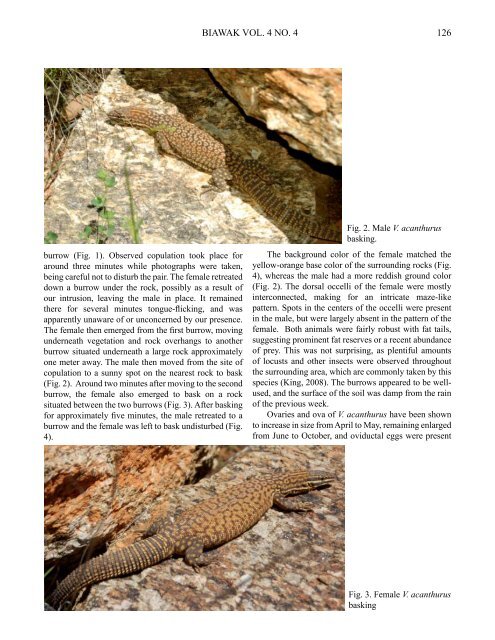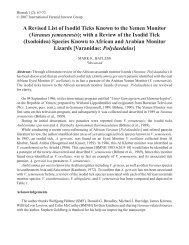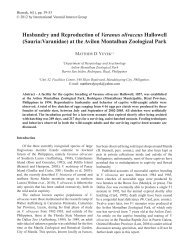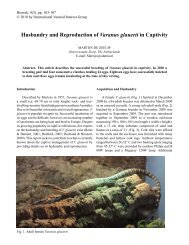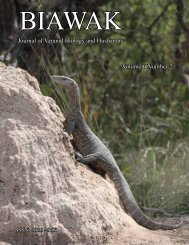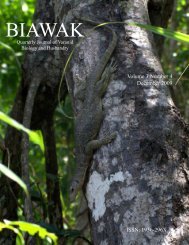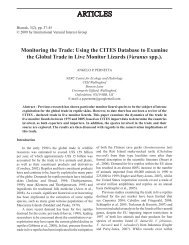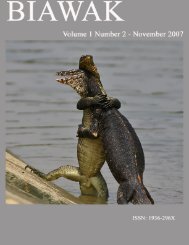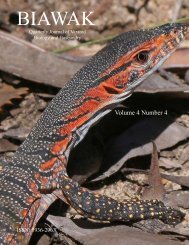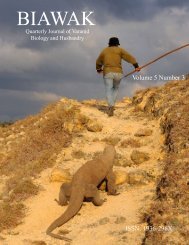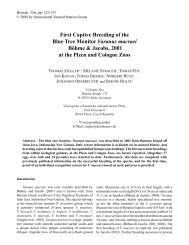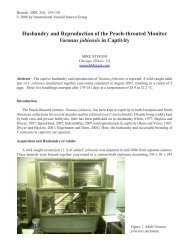BIAWAK - International Varanid Interest Group
BIAWAK - International Varanid Interest Group
BIAWAK - International Varanid Interest Group
- No tags were found...
Create successful ePaper yourself
Turn your PDF publications into a flip-book with our unique Google optimized e-Paper software.
<strong>BIAWAK</strong> VOL. 4 NO. 4 126<br />
burrow (Fig. 1). Observed copulation took place for<br />
around three minutes while photographs were taken,<br />
being careful not to disturb the pair. The female retreated<br />
down a burrow under the rock, possibly as a result of<br />
our intrusion, leaving the male in place. It remained<br />
there for several minutes tongue-flicking, and was<br />
apparently unaware of or unconcerned by our presence.<br />
The female then emerged from the first burrow, moving<br />
underneath vegetation and rock overhangs to another<br />
burrow situated underneath a large rock approximately<br />
one meter away. The male then moved from the site of<br />
copulation to a sunny spot on the nearest rock to bask<br />
(Fig. 2). Around two minutes after moving to the second<br />
burrow, the female also emerged to bask on a rock<br />
situated between the two burrows (Fig. 3). After basking<br />
for approximately five minutes, the male retreated to a<br />
burrow and the female was left to bask undisturbed (Fig.<br />
4).<br />
Fig. 2. Male V. acanthurus<br />
basking.<br />
The background color of the female matched the<br />
yellow-orange base color of the surrounding rocks (Fig.<br />
4), whereas the male had a more reddish ground color<br />
(Fig. 2). The dorsal occelli of the female were mostly<br />
interconnected, making for an intricate maze-like<br />
pattern. Spots in the centers of the occelli were present<br />
in the male, but were largely absent in the pattern of the<br />
female. Both animals were fairly robust with fat tails,<br />
suggesting prominent fat reserves or a recent abundance<br />
of prey. This was not surprising, as plentiful amounts<br />
of locusts and other insects were observed throughout<br />
the surrounding area, which are commonly taken by this<br />
species (King, 2008). The burrows appeared to be wellused,<br />
and the surface of the soil was damp from the rain<br />
of the previous week.<br />
Ovaries and ova of V. acanthurus have been shown<br />
to increase in size from April to May, remaining enlarged<br />
from June to October, and oviductal eggs were present<br />
Fig. 3. Female V. acanthurus<br />
basking


